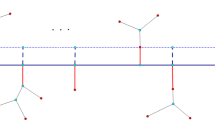Abstract
In this paper, we present the design of a Polynomial Time Approximation Scheme (PTAS) for the Grade of Service Steiner Minimum Tree (GOSST) problem, which is known to be NP-Complete. Previous research has focused on geometric analyses and different approximation algorithms have been designed. We propose a PTAS that provides a polynomial time, near-optimal solution with performance ratio 1+∈. The GOSST problem has some important applications. In network design, a fundamental issue for the physical construction of a network structure is the interconnection of many communication sites with the best choice of the connecting lines and the best allocation of the transmission capacities over these lines. Good solutions should provide paths with enough communication capacities between any two sites, with the least network construction costs. Also, the GOSST problem has applications in transportation, for road constructions and some potential uses in CAD in terms of interconnecting the elements on a plane to provide enough flux between any two elements.
Similar content being viewed by others
References
Arora, S. (1996), Polynomial-Time Approximation Schemes for Euclidean TSP and other Geometric Problems, Proceedings of 37th IEEE Symposium on Foundations of Computer Science, pp. 2–12.
Arora, S. (1997), Nearly Linear Time Approximation Schemes for Euclidean TSP and other Geometric Problems, Proceedings of 38th IEEE Symposium on Foundations of Computer Science, pp. 554–563.
Balakrishnan, A., Magnanti, T.L. and Mirchandani, P. (1994), Modeling and Heuristic Worst-Case Performance Analysis of the Two-level Network Design Problem, Management Science 40, 846–867.
Cockayne, E.J. and Hewgill, D.E. (1986), Exact Computation of Steiner Minimal Trees in the Plane, Information Processing Letters 22, 151–156.
Cockayne, E.J. and Hewgill, D.E., (1992), Improved Computation of Plane Steiner Minimal Trees, Algorithmica 7, 219–229.
Colbourn, C.J. and Xue, G. (2000), Grade of Service Steiner Trees on a Series-Parallel Network, in Du, D.Z. Smith, J.M. and Rubinstein, J.H. (eds)., Advances in Steiner Trees, Kluwer Academic Publishers, Dordrecht, pp. 163–174.
Current, J.R., Revelle, C.S. and Cohon, J.L. (1986), The hierarchical network design problem, European Journal of Operational Research 27, 57–66.
Du, D.Z. and Hwang, F.K. (1990), An Approach for Proving Lower Bounds: Solution of Gilbert-Pollak Conjecture on Steiner Ratio, Proceedings of IEEE 31st FOCS, 76–85.
Du, D.Z., Lu, B., Ngo, H. and Pardalos, P.M. (2000), Steiner Tree Problems, manuscript.
Duin, C. and Volgenant, A. (1991), The Multi-weighted Steiner Tree Problem, Annals of Operations Research 33, 451–469.
Garey, M.R., Graham, R.L. and Johnson, D.S. (1997), The Complexity of Computing Steiner Minimal trees, SIAM Journal of Applied Mathematics 32, 835–859.
Gilbert, E.N. and Pollack, H.O. (1968), Steiner Minimal Trees, SIAM Journal on Applied Mathematics 16, 1–29.
Hwang, F.K. (1991), A Primer of the Euclidean Steiner Problem, Annals of Operations Research 33, 73–84.
Hwang, F.K., Richard, D.S. and Winter, P. (1992), The Steiner Tree Problem, in Annals of Discrete Mathematics 53, North-Holland, Amsterdam. 448 J. KIM ET AL.
Melzak, Z.A. (1961), On the Problem of Steiner, Canadian Mathematics Bulletin 4, 143–148.
Mirchandani, P. (1996), The Multi-tier Tree Problem, INFORMS Journal on Computing 8, 202–218.
Sarrafzadeh, M., Lin, W.-L. and Wong, C.K. (1998), Floating Steiner Trees, IEEE Transactions on Computers 47, 197–211.
Smith, M.J. and Toppur, B. (1997), Euclidean Steiner Minimal Trees, Minimum Energy Configurations, and the Embedding Problem of Weighted Graphs in E3, Discrete Applied Mathematics 71, 187–215.
Winter, P. (1985), An Algorithm for the Steiner problem in the Euclidean Plane, Networks 15, 323–345.
Winter, P. and Zachariasen, M. (1996), Large Euclidean Steiner Minimum Trees in an Hour, Technical report 96/34, http://www.diku.dk/pawel/publications.html.
Winter, P. and Zachariasen, M. (1998), Large Euclidean Steiner Minimum Trees: an improved exact algorithm, Networks 30, 149–166.
Xue, G.L., Lin, G.H. and Du, D.Z. (2001), Grade of Service Steiner Minimum Trees in the Euclidean Plane, Algorithmica, 31, 479–500.
Zelikovsky, A. (1993), An 11 6-Approximation Algorithm for the Network Steiner Problem, Algorithmica 9, 463–470.
Author information
Authors and Affiliations
Rights and permissions
About this article
Cite this article
Kim, J., Cardei, M., Cardei, I. et al. A Polynomial Time Approximation Scheme for the Grade of Service Steiner Minimum Tree Problem. Journal of Global Optimization 24, 437–448 (2002). https://doi.org/10.1023/A:1021298822593
Issue Date:
DOI: https://doi.org/10.1023/A:1021298822593




